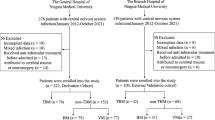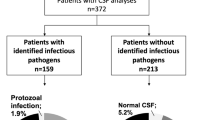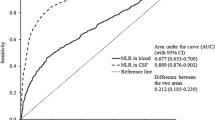Abstract
A previously reported statistical model based on a combination of four parameters (total polymorphonuclear cell count in cerebrospinal fluid (CSF), CSF/blood glucose ratio, age and month of onset) appeared effective in differentiating acute viral meningitis (AVM) from acute bacterial meningitis (ABM). The objectives of this study were to validate this model on a large independent sample of patients with acute meningitis and to build and validate a new model based on this sample. Of 500 consecutive cases of community-acquired meningitis reviewed retrospectively, 115 were ABM, 283 were AVM and 102 were of uncertain etiology. For each of the ABM and AVM cases, the probability of ABM versus AVM (pABM) was calculated for both models. Sensitivity, specificity and predictive values as well as areas under the receiver operating characteristic (ROC) curves were calculated for both models. The original model proved an accurate and reliable diagnostic test. Its area under the ROC curve was 0.981. For pABM=0.1, its negative and positive predictive values were 0.99 and 0.68, respectively. The new model retained four slightly different independent variables: CSF protein level, total CSF polymorphonuclear cell count, blood glucose level and leukocyte count. Its area under the ROC curve was 0.991 and, for pABM=0.1, its negative and positive predictive values were 0.99 and 0.85, respectively. In conclusion, both models provide a valuable aid in differentiating AVM from ABM. They should be further evaluated in a prospective appraisal of their contribution to therapeutic decision making.
Similar content being viewed by others
References
Geiseler PJ, Nelson KE, Levin S, Reddi KT, Moses VK: Community-acquired purulent meningitis: a review of 1,316 cases during the antibiotic era, 1954–1976. Reviews of Infectious Diseases 1980, 2: 725–745.
Landaas S, Von der Lippe B: Chemical analyses for early differential diagnosis between bacterial and viral meningitis. Scandinavian Journal of Clinical and Laboratory Investigations 1985, 45: 525–529.
Briem H: Comparison between cerebrospinal fluid concentrations of glucose, total protein, chloride, lactate, and total amino acids for the differential diagnosis of patients with meningitis. Scandinavian Journal of Infectious Diseases 1983, 15: 277–284.
BenGershôm E, Briggeman-Mol GJJ, de Zegher F: Cerebrospinal fluid C-reactive protein in meningitis: diagnostic value and pathophysiology. European Journal of Pediatrics 1986, 145: 246–249.
Lindquist L, Linné T, Hansson LO, Kalin M, Axelsson G: Value of cerebrospinal fluid analysis in the differential diagnosis of meningitis: a study in 710 patients with suspected central nervous system infection. European Journal of Clinical Microbiology & Infectious Diseases 1988, 7: 374–380.
Spanos A, Harrell FE, Durack DT: Differential diagnosis of acute meningitis. An analysis of the predictive value of initial observations. Journal of the American Medical Association 1989, 262: 2700–2707.
Baker RC, Lenane AM: The predictive value of cerebrospinal fluid differential cytology in meningitis. Pediatric Infectious Disease Journal 1989, 8: 329–330.
Fletcher RH, Fletcher FW, Wagner EW: Diagnostic test. In: Clinical epidemiology, the essentials. Williams & Wilkins, Baltimore, 1982, p. 41–58.
Hanley JA, McNeil BJ: The meaning and use of the area under a receiver operating characteristics (ROC) curve. Radiology 1982, 143: 29–36.
Hosmer DW, Lemeshow S: Applied logistic regression. John Wiley, New York, 1989, p. 140–145.
Hanley JA, McNeil BJ: A method of comparing the areas under receiver operating characteristic curves derived from the same cases. Radiology 1983, 148: 839–843.
Nye FJ: The value of initial laboratory investigations in the management of meningitis. Journal of Infection 1983, 7: 31–38.
Swartz MN, Dodge PR: Bacterial meningitis—a review of selected aspects. New England Journal of Medicine 1965, 272: 779–787.
McKinney WP, Heudebert GR, Harper SA, Young MJ, McIntire DD: Validation of a clinical prediction rule for the differential diagnosis of acute meningitis. Journal of General Internal Medicine 1994, 9: 8–12.
Author information
Authors and Affiliations
Rights and permissions
About this article
Cite this article
Hoen, B., Viel, J.F., Paquot, C. et al. Multivariate approach to differential diagnosis of acute meningitis. Eur. J. Clin. Microbiol. Infect. Dis. 14, 267–274 (1995). https://doi.org/10.1007/BF02116518
Issue Date:
DOI: https://doi.org/10.1007/BF02116518




